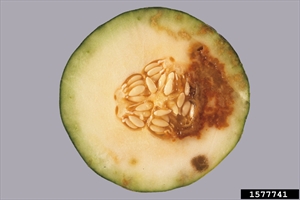Fruit blotch; it is also known as bacterial fruit blotch.
Pacific Pests, Pathogens and Weeds - Online edition
Pacific Pests, Pathogens & Weeds
Watermelon fruit blotch (196)
Acidovorax citrulli; previously this bacterium was named Acidovorax avenae subsp. citrulli, and when first isolated from watermelon, it was Pseudomonas pseudoalcaligenes subsp. citrulli. Several strains exist.
Asia, North, South and Central America, the Caribbean, Europe, Oceania. It has been recorded from Australia, Guam, and Northern Mariana Islands.
Cucurbits. Watermelon, cantaloupe and honey melons are the most susceptible. Wild cucurbits are also hosts.
The disease causes a seedling blight, leaf spots and fruit symptoms, and under conditions of high humidity and temperature can be devastating. The fruit blotch is the most characteristic (Photo 1).
Water-soaked spots - greyish, lacking a clear margin - occur on the cotyledons, the first leaves. The spots join together and extend along the veins. On older leaves the water-soaked spots start at the margins and are V-shaped (Photo 2). Infections on the stems of seedlings can cause death; if the plants survive, the spots on the leaves turn from being water-soaked to dark brown. As plants mature, it is difficult to see the earlier infections, yet they produce bacteria which infect the fruit.
The symptoms on the fruits are more obvious; however, they do not appear until near harvest, even though infection occurs when the fruit are very young - 2-3 weeks after flowering. Small water-soaked spots occur that expand rapidly to oval or circular green areas with irregular margins, covering most of the upper surface (Photo 2). At first, the infections remain superficial, but later cracks appear in the fruits and rots develop that extend to the seeds (Photo 3).
On honeydew melons, the spots are 3-10 mm, brown and cracked, with water-soaked margins.
Spread of the bacterium is on or in the seed, and this leads to infection of the young leaves as they emerge. In nurseries, the bacteria are then splashed to nearby plants during watering. Further spread occurs in the field by wind-driven rain, by contact with people, and on equipment. Survival of the bacterium between crops is also associated with the seed, as well as on 'volunteer' (self-sown) plants, and weeds. There is evidence that the bacterium can infect seeds directly through the flowers.
The disease is more serious on watermelon, but it also occurs on cantaloupe melon and on pumpkin, and it was recorded on squash in the US in 2011.
When major epidemics of this disease occurred, beginning in the US in 1989, there were losses in some fields of more than 90%. Outbreaks still occur, and losses were still being recorded in the late 1990s.
Look for the water-soaked spots on the youngest leaves and stems; those on the stems later become darker. Look for the characteristic dark green blotches on the top surface of the fruit that occur in the field. Growers should carefully check the first leaves of cotyledons for infections, and if they occur contact agriculture authorities so that isolations and identifications can be made.
Molecular methods for the detection of the different strains have been reported.
BIOSECURITY
Countries free from fruit blotch disease should take all practical measures to prevent its introduction and further spread. Since the outbreaks of the 1980s, seed grow-out tests have been standardised and molecular tests improved.
CULTURAL CONTROL
Before planting:
- Ensure that seed is certified free from the bacterium.
- Practice crop rotation. Do not plant on land for at least 2 years where the disease has been identified.
- Check all the seedlings in the nursery before planting in the field. Especially, check plants for infection after heavy rains and storms.
- Hygiene in nursery is important. Do not handle plants in the nursery after visiting those in the field; wash hands, tools and pots. If an outbreak of the bacterium occurs in the nursery, spray with 0.5% sodium hypochlorite (bleach), and wait for 2-3 weeks before restocking.
- Plant crops as far as possible from those where watermelons, and other cucurbits, are growing or where they were planted previously.
During growth:
- If irrigation is used, use drip rather than overhead.
- Remove weeds (and 'volunteer' plants) that are related to cucurbits from within and around the watermelon fields.
- If there is an outbreak of the disease, do not work in the field if the foliage is wet.
- Take care to clean equipment before moving it from infected to healthy fields.
After harvest:
- Destroy any volunteer plants, including any debris that remains from the harvest. This should be burnt or preferably buried.
RESISTANT VARIETIES
Tolerance of varieties is said to vary with rind colour. Dark green varieties are those with the more tolerant fruit, those with light and dark green stripes less so, and those with light rind colour least of all.
CHEMICAL CONTROL
Use copper fungicides if symptoms are detected early in the growing season.
____________________
When using a pesticide, always wear protective clothing and follow the instructions on the product label, such as dosage, timing of application, and pre-harvest interval. Recommendations will vary with the crop and system of cultivation. Expert advice on the most appropriate pesticide to use should always be sought from local agricultural authorities.
AUTHOR Grahame Jackson
Information from CABI (2019) Acidovorax citrulli (fruit blotch) Crop Protection Compendium. (https://www.cabi.org/cpc/datasheet/2676); and Acidovorax citrulli. Wikipedia. (https://en.wikipedia.org/wiki/Acidovorax_citrulli); and from Islam MR (2019) Development of molecular markers for detection of Acidovorax citrulli strains causing bacterial fruit blotch disease in melon. International Journal of Molecular Sciences 20(11):2715. Photo 1 Gerald Holmes, California Polytechnic State University at San Luis Obispo, Bugwood.org. Photo 2 George Wall, formerly CALS/AES University of Guam. Photo 3 Jason Brock, University of Georgia, Bugwood.org.
Produced with support from the Australian Centre for International Agricultural Research under project PC/2010/090: Strengthening integrated crop management research in the Pacific Islands in support of sustainable intensification of high-value crop production, implemented by the University of Queensland and the Secretariat of the Pacific Community.






